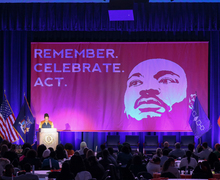Number of SU full-time faculty rises, despite national trend
The number of full-time faculty at Syracuse University has been increasing, defying a national trend at universities of a steady drop in the percentage of full-time faculty.
For the 2009-10 academic year, the university employs 942 full-time professors. This is more than the previous year, when there were 934, according to SU’s chapter of the American Association of University Professors’ annual salary report.
This increase in full-time faculty defies a national trend of universities hiring fewer full-time faculty members. The amount of full-time faculty at private colleges in the U.S. has declined 9 percent since 1997, according to a report by the American Federation of Teachers.
In place of these full-time professors, universities have been hiring more part-time, or adjunct, instructors and graduate student faculty, the report said.
The university has yet to follow this trend because the part-time faculty here can unionize, said Patrick Cihon, an associate professor in the Martin J. Whitman School of Management who compiled SU’s salary report.
Full-time faculty at private universities are not protected by federal labor laws and cannot unionize, but part-time faculty have begun to organize into unions over the past 10 years, Cihon said.
The union at SU is called Adjuncts United and is affiliated with New York State United Teachers, according to the group’s Web site.
The university has also been able to maintain its number of full-time staff by hiring full-time faculty to non-tenure-track positions.
These are full-time positions with one- to three-year contracts, rather than the usual six-year contract, which usually leads to the university granting the professor tenure, after which they can stay at the university as long as they choose. These positions save the university money because they are used to teach more courses than a regular professor would and there is less commitment, Cihon said.
Non-tenure-track faculty can also be instructors who have a lot of professional background but aren’t interested in an academic career, Cihon said. For example, the S.I. Newhouse School of Public Communications employs some non-tenure-track professionals whose full-time jobs are at local papers.
The number of full-time, non-tenure-track faculty at SU has only grown by about 2 percent during the past two years, according to the salary report, but it is a relatively new group of full-time faculty. Non-tenure-track faculty represents 11.5 percent of SU’s full-time faculty, according to the salary report.
The university is saving money this year by putting a freeze on all salaries for full-time faculty, said John Brulé, a research professor emeritus for the L.C. Smith College of Engineering and Computer Science. But there is not a freeze on hiring, and some colleges have filled vacancies since last year, he said.
Some faculty at SU said they believe having more full-time professors is an ideal scenario. Susan Wadley, associate dean for the College of Arts and Sciences, said her school always prefers to have full-time faculty.
Part-time faculty is mainly used for writing or foreign language courses that can have hundreds of sections that need to be taught every year, she said.
Some students said they see advantages in faculty other than traditional professors.
Ben Ferry, a junior mechanical engineering major, said he believes professors aren’t necessarily the best teachers.
‘Sometimes professors can be a little too preoccupied,’ Ferry said, ‘and some grad students are really good at teaching.’
Published on March 2, 2010 at 12:00 pm





